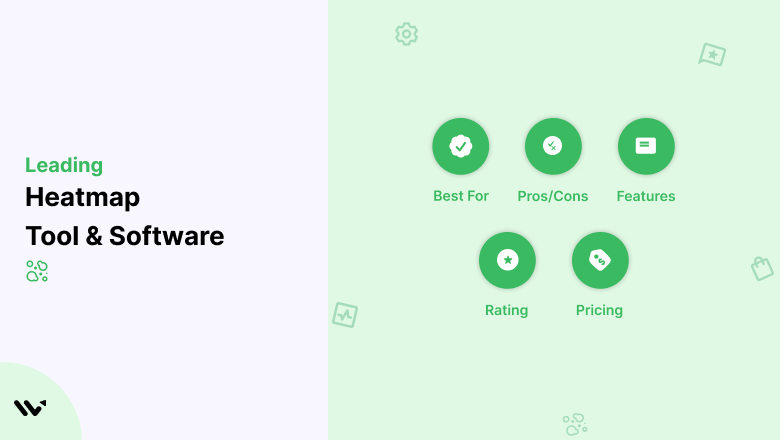Heatmap software tools help visualize data. They show user behavior on websites.
Understanding how visitors interact with your website is crucial. Heatmap tools make this task easier by providing a visual representation of data. These tools highlight the most and least engaging areas of your site. With heatmaps, you can see where users click, scroll, and hover.
This information helps improve user experience and design. Businesses can optimize their websites based on these insights. Knowing what works and what doesn’t is key. Heatmap tools offer a simple way to gather this data. They help turn visitor actions into actionable insights. Ready to explore more about these tools? Let’s dive in!
Introduction To Heatmap Software
Understanding how users interact with your website is crucial. Heatmap software tools provide a visual representation of user behavior. They show where users click, scroll, and hover. This data helps improve user experience and site performance.
What Is Heatmap Software?
Heatmap software is a tool that tracks user interactions. It captures data on clicks, scrolls, and hovers. This data is then displayed as a heatmap. Heatmaps use colors to represent data intensity. Red areas show high user activity, while blue areas show low activity.
Heatmap tools help identify popular and ignored areas on your site. They provide insights into user behavior. This information is essential for optimizing your website. It helps in making data-driven decisions.
Importance In User Engagement
Heatmap software plays a vital role in user engagement. It helps you understand what attracts users’ attention. You can see which elements users interact with the most.
By analyzing heatmaps, you can improve your website layout. You can place important content where users are most likely to see it. This increases user engagement and retention.
Heatmaps also help in identifying usability issues. If users are not interacting with a crucial element, it might be hard to find. You can redesign these elements to enhance user experience.
In summary, heatmap software tools are essential for improving user engagement. They provide valuable insights into user behavior. These insights help in optimizing website performance.
Types Of Heatmaps
Understanding the different types of heatmaps can help you make better decisions for your website. Heatmaps show how users interact with your site. They reveal areas where users click, scroll, or move their mouse. Let’s explore the main types of heatmaps and how they can benefit you.
Click Heatmaps
Click heatmaps show where users click on a webpage. They highlight popular and ignored areas. By analyzing these maps, you can see which elements users find engaging. This helps you to optimize your call-to-action buttons and links.
Consider this table for a quick overview:
| Feature | Benefit |
|---|---|
| Clickable areas | Identify high and low click zones |
| User interaction | Improve website layout based on user behavior |
Scroll Heatmaps
Scroll heatmaps show how far users scroll down a page. They reveal where users lose interest or stop reading. This helps you place important content in the right spots. You can see if users are missing out on key information at the bottom of the page.
For quick reference, here’s a list of benefits:
- Identify drop-off points
- Optimize content placement
- Improve user engagement
Mouse Movement Heatmaps
Mouse movement heatmaps track where users move their mouse. They help you understand user attention and focus areas. This data shows which sections of your page draw the most interest. It also helps you improve navigation and user experience.
Key benefits include:
- Understand user interest areas
- Improve page layout
- Enhance navigation
Top Heatmap Software Tools
Heatmap software tools provide valuable insights into user behavior on your website. These tools help to visualize where users click, scroll, and spend most of their time. Understanding these patterns can help improve user experience and increase conversions. Let’s look at some top heatmap software tools.
Hotjar
Hotjar is a popular heatmap tool that offers a range of features. It provides click maps, scroll maps, and move maps. These features help you see where users are engaging the most.
- Click maps show where users click on a page.
- Scroll maps indicate how far users scroll down a page.
- Move maps track where users move their mouse.
Hotjar also offers session recordings, which allow you to watch user sessions in real-time. This can provide more context to the heatmap data.
Crazy Egg
Crazy Egg offers heatmaps, scrollmaps, and confetti reports. These reports show click patterns from different user segments.
- Heatmaps visualize areas of high and low engagement.
- Scrollmaps help you understand user scroll behavior.
- Confetti reports break down clicks by traffic source, device, and more.
Crazy Egg also provides A/B testing tools to compare different page versions. This helps in understanding which design works better.
Mouseflow
Mouseflow is another powerful heatmap tool. It offers click, scroll, and movement heatmaps. This helps in understanding user interaction on your website.
- Click heatmaps show where users click the most.
- Scroll heatmaps indicate how far down users scroll.
- Movement heatmaps track mouse movement patterns.
Mouseflow also provides session replays and funnel analysis. These features help identify where users drop off in the conversion process.
Features To Look For
Choosing the right heatmap software tool can be challenging. You want a tool that meets your needs and enhances your website’s performance. Here are some key features to consider:
User-friendly Interface
A user-friendly interface is crucial. You need a tool that is easy to navigate. If the software is too complex, it can slow you down. Look for clear menus and simple controls. This ensures you can focus on analyzing data, not on figuring out the software.
Comprehensive Analytics
Analytics are the heart of heatmap tools. The software should provide detailed insights. This includes data on clicks, scrolls, and user interactions. Comprehensive analytics help you understand user behavior. This understanding can improve your website’s design and functionality.
Integration Options
Good integration options are essential. Your heatmap tool should work well with other software. This includes content management systems and analytics tools. Seamless integration ensures you get a complete picture of user behavior. It also saves time and effort, making your workflow smoother.
Implementing Heatmaps On Websites
Implementing heatmaps on websites can enhance user experience. It provides insights on visitor behavior. This section will guide you through the process. From installation to setting up tracking, we will cover all the steps.
Installation Process
The first step is to choose your heatmap software tool. Popular choices include Hotjar, Crazy Egg, and Mouseflow. Once you select the tool, follow these simple steps:
- Sign up for an account on the chosen tool’s website.
- Navigate to the dashboard and find the installation code.
- Copy the provided JavaScript snippet.
- Paste this code into the
section of your website’s HTML. - Save the changes and publish your website.
Your heatmap software is now installed. Next, set up the tracking to start gathering data.
Setting Up Tracking
Setting up tracking ensures you collect relevant data. Follow these steps to configure tracking:
- Log in to your heatmap software dashboard.
- Select the website where you installed the code.
- Go to the tracking settings or configuration section.
-
Define your tracking goals:
- Clicks
- Mouse movements
- Scroll depth
- Enable tracking for specific pages or the entire site.
- Save your settings.
Your tracking setup is now complete. You can start viewing heatmap data within a few hours. This data will show where users click, how they navigate, and how far they scroll.
Analyzing Heatmap Data
Analyzing heatmap data is crucial for understanding user interactions on your website. It helps you see where users click, scroll, and hover. This insight is valuable for improving user experience and increasing conversions. Let’s dive into some key aspects of analyzing heatmap data.
Identifying User Patterns
Heatmap software tools make it easy to identify user patterns. You can see where users click the most. This shows you which elements draw attention. You can also track scrolling behavior. This reveals how far users scroll down your pages. Identifying these patterns helps you understand what works and what needs improvement.
Understanding User Behavior
Understanding user behavior is another advantage of heatmap tools. You can see where users hover their mouse. This indicates areas of interest. You can also track how users navigate your site. This helps you understand the user journey. Knowing this can guide you in making your site more user-friendly.
Boosting User Engagement
Heatmap software tools can significantly boost user engagement. They offer insights into how users interact with your website. By analyzing these patterns, you can make informed decisions to improve your site. This leads to higher user satisfaction and increased interaction.
Improving Website Design
Heatmap tools show where users click, scroll, and hover. This data helps identify which elements attract attention and which get ignored. You can then adjust the layout to highlight important features. A well-designed site keeps users engaged longer.
Enhancing User Experience
Understanding user behavior is key to enhancing their experience. Heatmaps reveal pain points and areas of confusion. Fixing these issues makes navigation smoother. Users will find what they need faster and will likely return.

Credit: wisernotify.com
Increasing Conversion Rates
Increasing conversion rates is crucial for any business. Heatmap software tools help achieve this by providing valuable insights. They show user behavior on your website, highlighting areas of interest and potential problems.
Optimizing Call To Actions
Call to Actions (CTAs) are key to conversions. Heatmap tools reveal where users click and how they interact with CTAs. This data helps in placing CTAs where they are most effective.
Consider these steps:
- Analyze: Examine the heatmap data to see which CTAs get the most attention.
- Test: Try different positions and designs for your CTAs.
- Optimize: Place CTAs in the hotspots identified by the heatmap.
Effective CTAs lead to higher engagement and conversions.
Streamlining Navigation
Easy navigation is critical for user satisfaction. Heatmap tools can show you where users struggle. This insight helps in simplifying the website’s structure.
Here’s how to streamline navigation:
- Identify: Use heatmap data to find confusing or unused navigation links.
- Simplify: Remove unnecessary links and make important ones more accessible.
- Test: Continuously test and refine based on heatmap feedback.
A streamlined navigation improves user experience and keeps visitors on your site longer. This can lead to more conversions.
Case Studies And Success Stories
Heatmap software tools have revolutionized the way businesses understand user behavior on their websites. By visually representing data, these tools provide insights that are invaluable for optimizing user experience and increasing conversions. In this section, we delve into some case studies and success stories that highlight the practical applications and benefits of using heatmap software tools.
Real-world Examples
Many businesses have seen a significant impact after implementing heatmap software. Here are a few real-world examples:
- eCommerce Site: An online store noticed users were not clicking on the top banner. The heatmap revealed that the banner’s design was too similar to the background. By changing the color scheme, they increased banner clicks by 20%.
- Blog: A popular blog found that readers were not scrolling past the first few paragraphs. The heatmap showed a sharp drop in attention. By breaking up the text with images and subheadings, they improved reader engagement by 15%.
- Travel Agency: A travel website saw that users often abandoned the booking page. The heatmap indicated confusion around the form fields. Simplifying the form layout led to a 25% increase in completed bookings.
Lessons Learned
From these examples, several important lessons were learned:
- Design Matters: Simple changes in design can lead to significant improvements in user interaction.
- User Journey: Understanding the user journey helps in identifying and resolving pain points effectively.
- Continuous Improvement: Regularly analyzing heatmaps ensures that the website remains user-friendly and efficient.
These case studies illustrate how heatmap software tools can transform user experience and drive business growth. By learning from these success stories, businesses can apply similar strategies to their own websites.

Credit: www.hotjar.com
Future Of Heatmap Software
The future of heatmap software is both promising and fascinating. With advancements in technology, these tools are becoming more sophisticated and user-friendly. Businesses can now understand user behavior on a deeper level. This understanding helps improve website usability and enhances user experience.
Emerging Trends
Several trends are shaping the future of heatmap software. One major trend is the use of AI and machine learning. These technologies offer more accurate insights. Another trend is the integration with other analytics tools. This creates a comprehensive view of user behavior. Additionally, there is a growing focus on mobile heatmaps. As more users access websites through mobile devices, understanding their behavior on small screens is crucial.
| Trend | Description |
|---|---|
| AI and Machine Learning | Provides more accurate insights into user behavior. |
| Integration with Analytics Tools | Creates a comprehensive view of user behavior. |
| Focus on Mobile Heatmaps | Helps understand behavior on small screens. |
Innovative Features
Future heatmap software will include many innovative features. One key feature is real-time heatmaps. These allow businesses to see user interactions as they happen. Another important feature is dynamic content analysis. This feature tracks how users interact with content that changes.
- Real-Time Heatmaps – View user interactions live.
- Dynamic Content Analysis – Track interactions with changing content.
Additionally, advanced segmentation will become more common. This allows businesses to analyze specific groups of users. For example, new visitors versus returning visitors. These features will make heatmap software even more powerful and effective.

Credit: www.fullstory.com
Frequently Asked Questions
What Is Heatmap Software Used For?
Heatmap software visualizes data using color gradients to show patterns. It’s used for website analytics, user behavior, and data analysis.
How Do Heatmaps Improve User Experience?
Heatmaps highlight popular areas on a website. This helps in optimizing layouts and improving user engagement and experience.
Can Heatmaps Track Mobile User Behavior?
Yes, heatmaps can track mobile user behavior. They provide insights on how users interact with mobile sites.
Are Heatmap Tools Easy To Use?
Most heatmap tools are user-friendly. They offer intuitive interfaces and easy setup processes for beginners.
Conclusion
Heatmap software tools offer valuable insights into user behavior. These tools help identify popular areas on your website. Understanding user interactions can improve website design and user experience. Choose the right heatmap tool to make informed decisions. Track, analyze, and optimize your site’s performance effectively.
With these tools, enhance user satisfaction and achieve your business goals. Explore various options and select the best fit for your needs. Start harnessing the power of heatmap software today. Your website’s success depends on understanding your audience. Make smarter choices with heatmap insights.

I am a passionate digital marketer with a strong expertise in SEO and article writing. With years of experience in crafting compelling content and optimizing it for search engines, I help businesses enhance their online visibility and drive organic traffic. Whether it’s creating engaging blog posts or implementing effective SEO strategies, I am dedicated to delivering results that make an impact.
